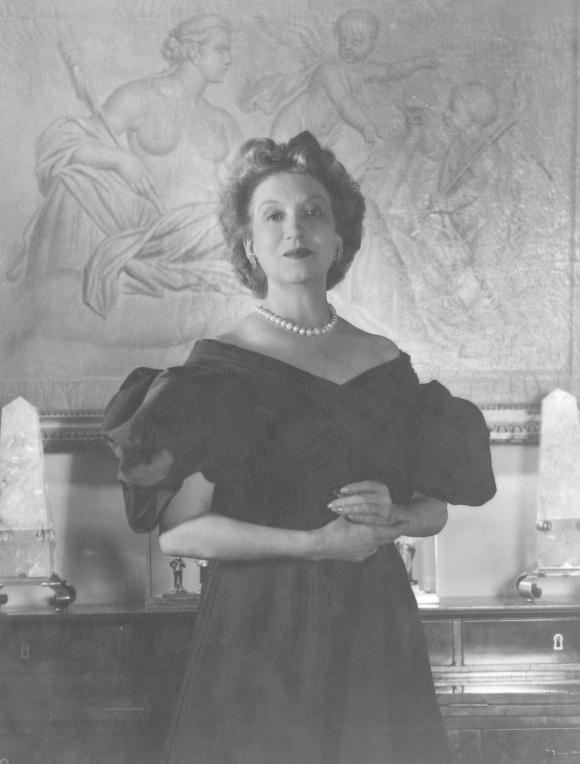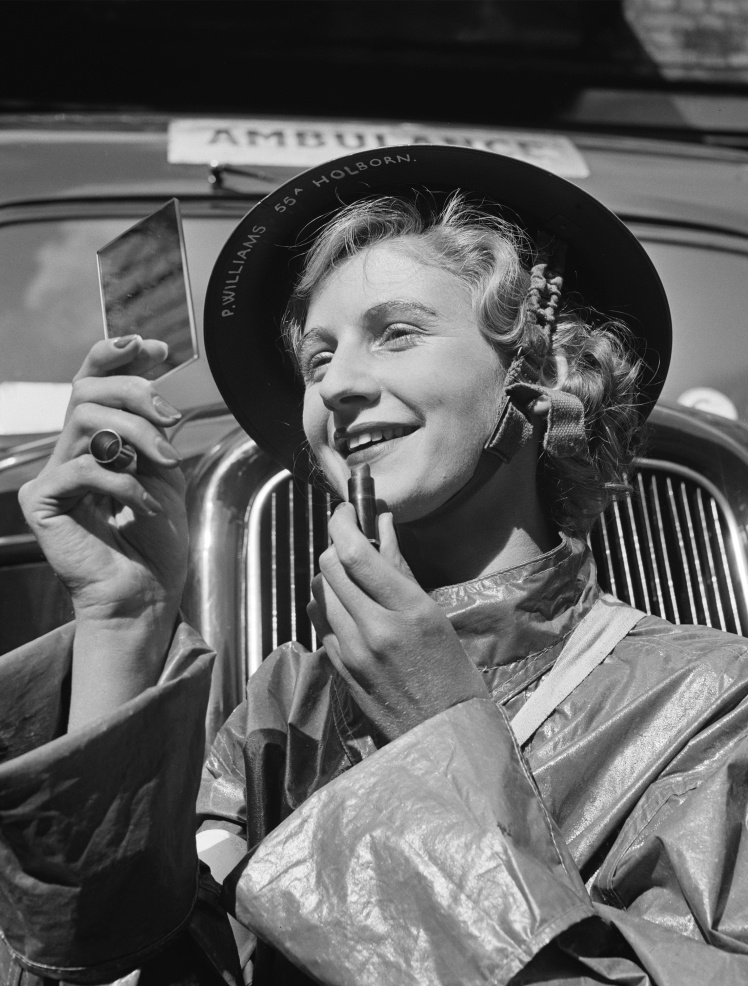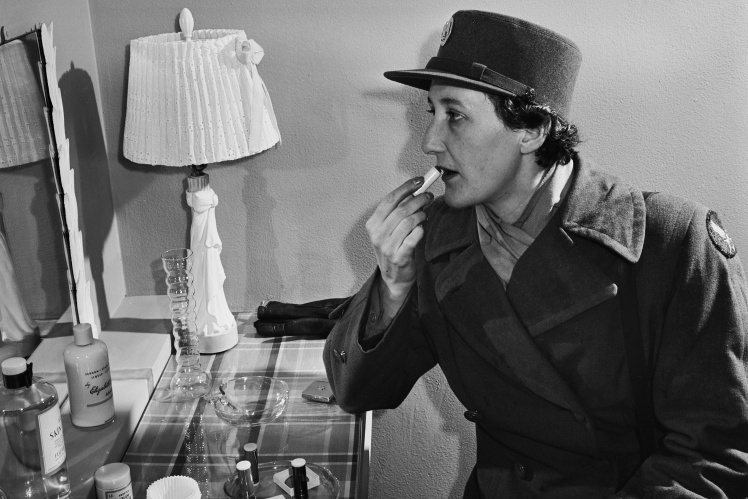At the turn of the 19th and 20th centuries, red lipstick and cosmetics were generally considered a sign of debauchery in the Puritan patriarchal societies of Europe and America. Of the "decent" women, only theatrical actresses had cosmetic bags in their wardrobe.
At the same time, the womenʼs rights movement intensified. And one of the symbols of civil disobedience was red lipstick. It happened almost by accident. In 1912, in New York, thousands of supporters of the suffrage movement marched past the salon of Elizabeth Arden — a Canadian businesswoman and founder of the future cosmetic empire.
Elizabeth Arden, 1947.
Getty Images / «Babel'»
Elizabeth also advocated for womenʼs rights, so she decided to hand out tubes of bright red lipstick to the protesters. The effect was really powerful when about 15 thousand women with "provocative" red lips shouted slogans. Inspired by this example, womenʼs activists in Europe, Australia and New Zealand also began using red lipstick in their rallies.
March of Suffragettes in New York, May 1912 (colorized photo).
Getty Images / «Babel'»
During the First World War, patriarchal society tried to use cosmetics as a tool to comply with gender norms. Then women gradually began to master those professions where they were not allowed before — they got jobs in factories, worked as tram drivers, postmen, and so on. That is, men were replaced. Therefore, the cosmetics had to emphasize their "duty to remain a woman" and not to admire their temporary pass to the "male world".
French women working at an ammunition factory, 1914 (colorized photo).
Getty Images / «Babel'»
Helena Rubinstein, a well-known cosmetic tycoon of the time, created an advertisement in which women were told that taking care of their appearance was just as important as going to work in the morning. Rubinstein also spread her advertising campaign to housewives, declaring the use of cosmetics a manifestation of patriotism. And she told the Red Cross nurses that their duty to be combed, powdered and blushed was no less important than saving lives. All this brought Rubinstein a good profit.
American poster of the First World War with the image of a Red Cross nurse with red lipstick lips.
Getty Images / «Babel'»
And it was a truly revolutionary cultural shift in cosmetics. However, European and especially American society in the 1920s tried to re-impose pre-war Puritan morals on women. Lawmakers tried to outlaw cosmetics, and they were actively supported by religious organizations.
In 1920, the influential American Womenʼs Christian Sobriety Alliance won one of its major victories: a total ban on alcohol in the United States. A year later, union activists launched a campaign against cosmetics, especially red lipstick. But this time they failed to win. They limited themselves to declaring women who used cosmetics "prostitutes and hopeless heretics who cannot be re-educated".
Activists of the Womenʼs Christian Union of Sobriety break alcohol barrels found during a raid on April 14, 1929. Women and men do makeup before returning home from a country trip for the weekend, 1927.
Getty Images / «Babel'»
If in the mid-1920s make-up was still considered a bold move, in the 1930s everything changed. Hollywood has set the trend for bright lipstick, and movie stars and their makeup artists have increasingly shared their favorite products and beauty tips in lifestyle magazines. During the Great Depression, more and more women went to work and became even more independent. And cosmetics have become more diverse, more affordable and more compact. In the mid-1930s, womenʼs magazines wrote that "beauty is part of your job," and "brains, diplomas, and ambition are nothing without a good packaging".
Beauty expert Helena Rubinstein demonstrates the basic lines for applying makeup, 1935.
Getty Images / «Babel'»
On the eve of World War II, cosmetics were already commonplace for women. And with the beginning of the war it became a reminder of normal pre-war life. The British government has imposed strict regulations on various goods and even banned some of them. However, this did not apply to cosmetics and especially lipstick. "Cosmetics are as important to women as tobacco supplies are to men", the food ministry said. Even the British Prime Minister Winston Churchill himself advocated the idea that women should try to look as stylish as possible in wartime circumstances.
Workers at the military plant greet British Prime Minister Winston Churchill on December 7, 1942.
Getty Images / «Babel'»
Red lipstick became especially popular in those days. More and more women went to factories. And there they had to work in overalls, sometimes in special glasses, and hide their hair under scarves and hats. Therefore, lipstick remained the only thing that could emphasize femininity. To raise morale, the management of enterprises often distributed tubes of red lipstick to their employees free of charge. "Cosmetics worth a thousand pounds, which we give to girls, bring them more pleasure than cash," — said the head of one of the military plants. Therefore, the production of lipstick was reduced during the war, but never completely stopped.
Workers at one of the Royal Ordnance Factories, England, November 1943.
Getty Images / «Babel'»
And red lipstick has become one of the brightest symbols of patriotism, struggle, and ultimately, victory over Nazism. This was facilitated by Hitler himself. When he became chancellor in 1933, his Nazi party decided that the perfect German woman should not use cosmetics at all — they said that her natural "Aryan" beauty was enough. Similarly, German women were not recommended to wear jewelry, perfume, fur, and trousers. In this way, they wanted to get rid of the image of the Germans of the Weimar Republic — a democratic German state that lasted from the end of the First World War until the Nazis came to power.
Hitler especially hated lipstick. He was a vegetarian, and lipsticks in those days were made from animal fats. Among the list of prohibitions for visitors to Hitlerʼs country residence were the following items: avoid excessive makeup, no red lipstick and painted nails. The Führerʼs ally, the leader of the Italian fascists, Benito Mussolini, also had a negative attitude towards make-up.
Hitler shakes hands with the leaders of the Imperial Labor Service. This service supervised the compulsory labor service of German citizens on September 8, 1937.
Getty Images / «Babel'»
The British Ministry of Information, created in the early days of the war, took advantage of this. Officials have launched a large-scale propaganda campaign under the slogans "Beauty is your duty", "Lipstick is your weapon and you are soldiers of the rear". Now such slogans seem sexist, but at the time they worked so successfully that red lipstick became a symbol of disobedience even in the Nazi-occupied European territories.
An ambulance driver in London painted her lips red with lipstick on September 21, 1939. On June 14, 1943, the Air Defense Calculator tracked down enemy planes near London.
Getty Images / «Babel'»
World War II poster from the series "Beauty is your duty".
Duke University Libraries
In the United States, the Committee on Military-Industrial Production initially decided to stop the production of cosmetics. But it quickly changed its mind and declared that cosmetics "are not just necessary, but also vital". In 1941, red lipstick became mandatory for women who joined the US Army. Then came the heyday of Elizabeth Arden, who 30 years ago, at her own risk, distributed red lipstick to suffragettes. Now the US government has asked her to create a special shade of red for women, and lipstick and blush for military women. This is how the Montezuma Red appeared, which matched the red edging of the military uniform.
Pilots of the American Womenʼs Auxiliary Squadron, which drove fighter jets from factories to the front, 1943. American military paints lips with red lipstick, 1943.
Getty Images / «Babel'»
Her competitor Helena Rubinstein was not left out either. At the request of the government, she developed an "appearance care program that met current and future defense needs" for the Womenʼs Army Auxiliary Corps.
For civilian women, Arden has created a shade of Victory Red lipstick. And Rubinstein presented his own shade of red — Regimental Red. The trend for "military" red lipstick has been picked up by other manufacturers. This is how Fighting Red, Rocket Red, Patriot Red, Grenadier Red, and many others appeared. "It was patriotism that could be carried in a handbag", researchers describe the trend.
Victory Red lipstick advertising poster, 1940s.
Duke University Libraries
Red lipstick remained a hidden weapon after World War II. During the Cold War between the West and the USSR, it was used as a symbol of the fact that communism lags far behind in the production and availability of consumer goods.
Red lipstick is still a symbol of protest. In 2018, women and even men from Nicaragua painted their lips with red lipstick and uploaded their photos to social networks to protest against the dictatorship of President Daniel Ortega. It all started with an activist detained at a rally. She offered her roommates in the cellar to apply red lipstick, which was not taken away during the search. In 2019, in Chile, about ten thousand women took to the streets with black blindfolds and red lips — so they protested against sexual violence. Subsequently, similar actions took place in other countries. And in North Korea, red lipstick, makeup and unapproved hairstyles have become one of the symbols of youth resistance to the totalitarian state.
Translated from Ukrainian by Anton Semyzhenko.
We tell interesting stories to support your spirit and faith in victory. And you can support Babel:🔸 donate in hryvnia 🔸 in cryptocurrency 🔸 PayPal: [email protected].
Protest against sexual violence in the Chilean capital Santiago, November 29, 2019.
Getty Images / «Babel'»








